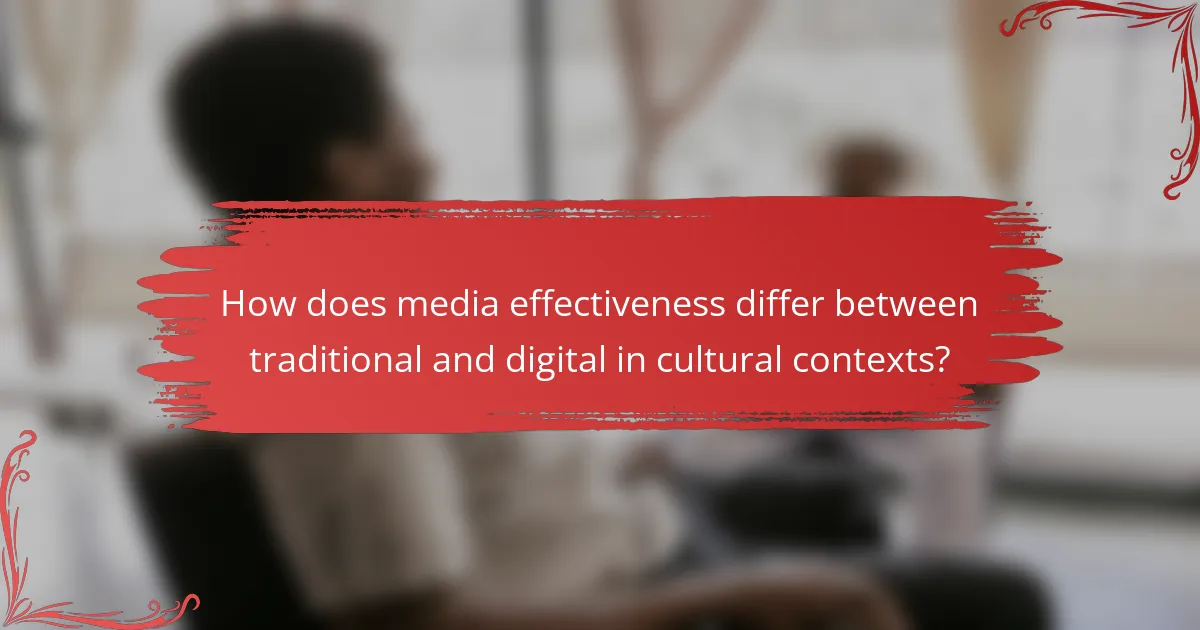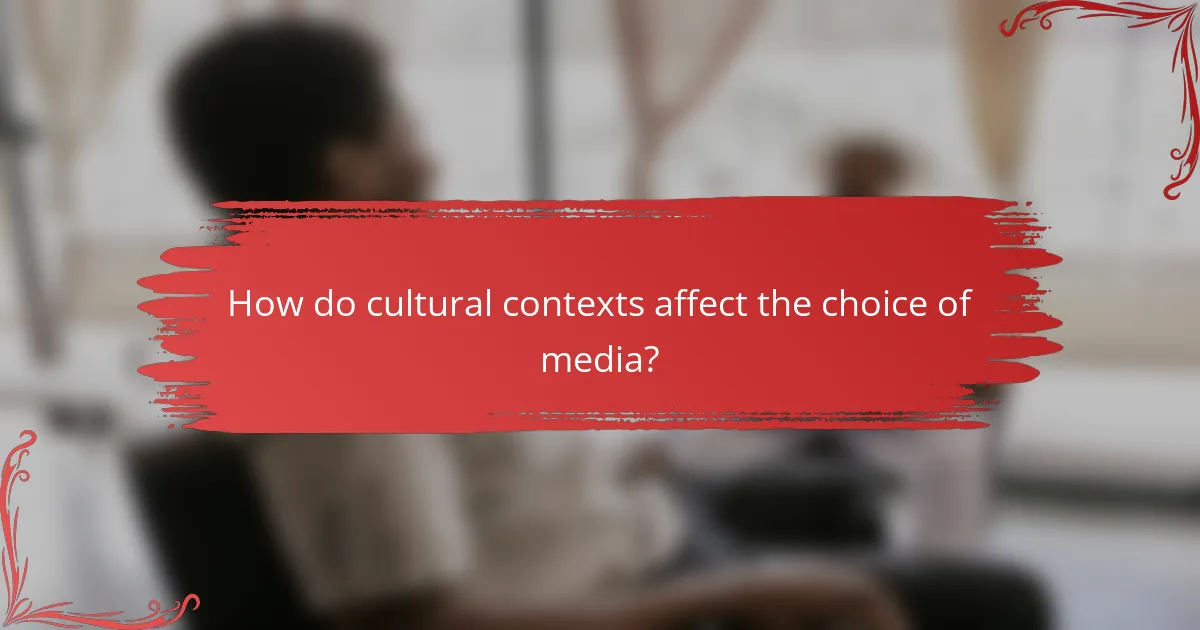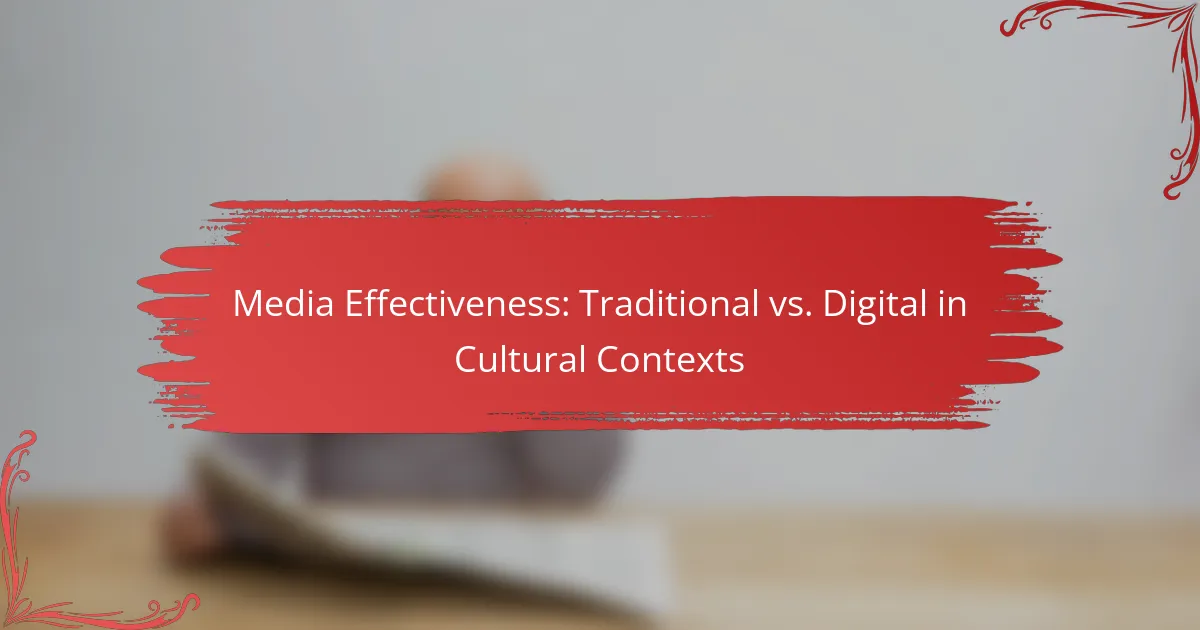Media effectiveness is shaped by the interplay between traditional and digital platforms, with cultural contexts playing a pivotal role. While traditional media tends to leverage established norms for broader reach, digital media excels in targeted engagement and real-time interaction. Recognizing audience demographics and cultural relevance is essential for optimizing media campaigns across diverse cultural landscapes.

How does media effectiveness differ between traditional and digital in cultural contexts?
Media effectiveness varies significantly between traditional and digital platforms, influenced by cultural contexts. Traditional media often relies on established norms and broader audience reach, while digital media offers targeted engagement and real-time interaction.
Traditional media effectiveness in cultural engagement
Traditional media, including television, radio, and print, tends to resonate well in cultures with strong communal values and established media consumption habits. These platforms often leverage storytelling and emotional appeal, fostering a sense of shared experience among audiences.
For example, a local television campaign during a cultural festival can effectively engage viewers by aligning with community traditions. However, the effectiveness can diminish in younger demographics who may prefer digital channels.
Digital media effectiveness in cultural engagement
Digital media excels in cultural engagement by allowing for personalized content and interactive experiences. Platforms like social media and streaming services enable brands to connect with niche audiences through targeted advertising and user-generated content.
For instance, a campaign on Instagram that highlights local artists can engage younger audiences more effectively than traditional ads. The immediacy and adaptability of digital media allow for real-time feedback and cultural responsiveness.
Comparative analysis of audience reach
Traditional media typically has a broader reach, making it effective for mass communication, especially in regions with limited internet access. It can capture large audiences quickly, but may struggle to engage specific cultural segments.
In contrast, digital media can reach targeted groups more efficiently, often leading to higher engagement rates. For example, a Facebook ad campaign can focus on specific cultural interests, reaching audiences that traditional media might overlook.
Impact of cultural values on media effectiveness
Cultural values significantly influence how audiences perceive and respond to different media types. In collectivist cultures, traditional media may be more effective due to its emphasis on community and shared narratives.
Conversely, in individualistic cultures, digital media’s focus on personal expression and interactivity may resonate more. Understanding these cultural nuances is crucial for marketers to tailor their strategies effectively, ensuring that the chosen media aligns with the audience’s values and preferences.

What are the key factors influencing media effectiveness?
Media effectiveness is influenced by various factors, including audience demographics, cultural relevance, and the chosen media format. Understanding these elements can significantly enhance the impact of media campaigns across different cultural contexts.
Target audience demographics
Demographics such as age, gender, income, and education level play a crucial role in determining media effectiveness. For instance, younger audiences may prefer digital platforms like social media, while older demographics might engage more with traditional media like television or print.
Marketers should analyze their target audience’s demographic data to tailor their media strategies effectively. Utilizing tools like surveys and analytics can help identify the preferred media channels for specific demographic groups, ensuring that messages reach the right people.
Cultural relevance of media formats
The cultural context in which media is consumed greatly affects its effectiveness. Certain media formats resonate more with specific cultures; for example, visual storytelling may be more impactful in cultures that value imagery over text. Understanding local customs and values is essential for selecting the appropriate media format.
To enhance cultural relevance, marketers should consider local trends and preferences when designing campaigns. Engaging local influencers or using culturally significant symbols can increase relatability and strengthen the connection with the audience, leading to higher engagement rates.

How do traditional advertising methods perform in diverse cultures?
Traditional advertising methods can vary significantly in effectiveness across different cultures due to varying values, communication styles, and media consumption habits. Understanding these cultural nuances is crucial for tailoring campaigns that resonate with local audiences.
Case studies of traditional media campaigns
One notable example is Coca-Cola’s “Share a Coke” campaign, which successfully localized its messaging in various countries by using popular names and culturally relevant phrases. In contrast, McDonald’s adapts its menu and advertising to reflect local tastes, such as offering rice dishes in Asian markets. These case studies illustrate how traditional media can be effectively tailored to fit cultural contexts.
Another example is the “Dove Real Beauty” campaign, which aimed to challenge beauty stereotypes globally. In different regions, Dove adjusted its messaging to align with local beauty standards, showcasing diverse representations of women. This approach helped the campaign resonate deeply with audiences, demonstrating the power of culturally aware traditional advertising.
Success metrics for traditional media
Measuring the success of traditional media campaigns often involves metrics such as reach, frequency, and engagement. Reach indicates how many people saw the advertisement, while frequency measures how often they encountered it. High reach combined with optimal frequency can lead to increased brand awareness and recall.
Additionally, tracking sales growth or market share changes post-campaign can provide insights into effectiveness. Surveys and focus groups can also gauge audience perception and emotional response to the campaign, offering qualitative data that complements quantitative metrics. It’s essential to establish clear objectives beforehand to evaluate success accurately.

What are the advantages of digital advertising in various cultural settings?
Digital advertising offers significant advantages in diverse cultural contexts, primarily through its ability to reach targeted audiences and adapt content in real-time. This flexibility allows brands to resonate more effectively with local customs and preferences, enhancing engagement and conversion rates.
Real-time analytics and audience targeting
Digital advertising enables advertisers to gather real-time analytics that inform audience targeting strategies. By analyzing user behavior, demographics, and cultural interests, brands can tailor their messages to specific groups, ensuring relevance and increasing the likelihood of engagement.
For instance, a campaign aimed at younger audiences in urban areas may leverage social media platforms popular among that demographic, while targeting older consumers in rural settings through email newsletters. This precision in targeting can lead to higher conversion rates and more efficient use of marketing budgets.
Flexibility and adaptability of digital content
The adaptability of digital content is a key advantage in various cultural settings. Advertisers can quickly modify their campaigns based on feedback and performance metrics, allowing for adjustments that align with local cultural nuances and preferences.
For example, a brand may initially launch a campaign in multiple languages to cater to diverse populations. If certain messages resonate better in specific regions, they can pivot their strategy to emphasize those elements, optimizing their impact. This level of flexibility is often not possible with traditional media, where changes can be costly and time-consuming.

How do cultural contexts affect the choice of media?
Cultural contexts significantly influence the choice of media by shaping preferences, consumption habits, and the effectiveness of various media types. Understanding these cultural nuances is essential for marketers and content creators to effectively engage their target audiences.
Regional preferences for media types
Different regions exhibit distinct preferences for media types based on cultural values and technological access. For instance, in many Western countries, digital media such as social media platforms and streaming services dominate, while in some Asian countries, traditional media like television and print still hold substantial influence.
Marketers should consider local preferences when planning campaigns. For example, in Eastern Europe, television remains a primary source of information, while in North America, online content consumption is rapidly increasing. Tailoring media strategies to align with these regional preferences can enhance engagement and effectiveness.
Influence of cultural norms on media consumption
Cultural norms dictate how and when people consume media, impacting everything from content type to platform choice. In collectivist cultures, for example, media that emphasizes community and family values tends to resonate more, while individualistic cultures may prefer content that highlights personal achievement and self-expression.
Additionally, factors such as language, humor, and societal issues play a crucial role in shaping media consumption. Advertisers should ensure that their messaging aligns with local cultural sensitivities to avoid miscommunication and backlash. Understanding these cultural norms can guide the development of relevant and appealing media content.

What are the emerging trends in media effectiveness?
Emerging trends in media effectiveness highlight the growing importance of integrating digital strategies with traditional media. As audiences become more fragmented, marketers are focusing on personalized content delivery and leveraging data analytics to enhance engagement and ROI.
Integration of AI in media strategy
The integration of artificial intelligence (AI) in media strategy is transforming how brands approach their marketing efforts. AI technologies enable companies to analyze vast amounts of data, predict consumer behavior, and tailor content to specific audience segments, enhancing overall media effectiveness.
For instance, AI-driven tools can optimize ad placements in real-time, ensuring that advertisements reach the right audience at the right moment. This not only improves engagement rates but also maximizes budget efficiency by reducing wasted impressions.
To effectively incorporate AI into media strategies, businesses should start by identifying key performance indicators (KPIs) that align with their goals. Regularly reviewing these metrics can help in adjusting strategies and ensuring that AI tools are delivering the desired outcomes. Avoid relying solely on AI; human oversight is crucial to interpret data insights accurately and maintain brand integrity.
